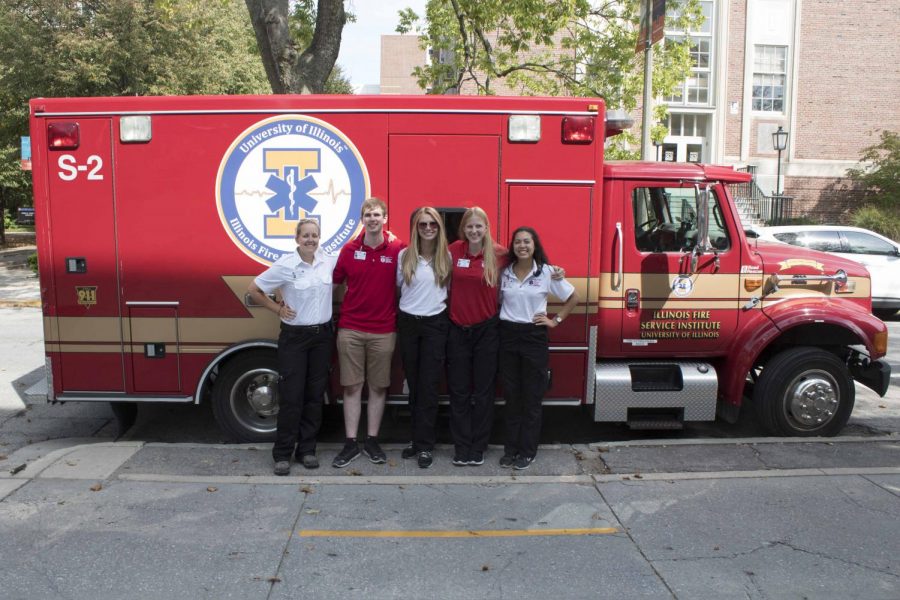EMT course provides valuable training for aspiring healthcare professionals
Photo courtesy of Elizabeth Woodburn
Students stand with an ambulance after completing the University’s EMT course. Only 24 students are admitted into the course in an effort to offer a hands-on skills and national homework required for courses across the country. For students to pass the class, they must receive an 80 percent or higher.
Jan 17, 2018
In the event of a medical emergency, most students’ instincts would be to reach for the phone and dial 911. An emergency medical technician (EMT) class on campus could change that instinct drastically.
Elizabeth Woodburn, Director of Education for Illini Emergency Medical Services, said that through the EMT course, students learn to assess and manage a wide variety of medical emergencies including cardiac, respiratory, diabetic and neurological as well as bleeding, shock and musculoskeletal injury management.
“IEMS has developed an academically and physically challenging EMT course that is offered,” Woodburn said. “It stresses academic and clinical abilities, interpersonal skills, critical thinking processes, decision-making abilities and the capacity for quick and appropriate judgment.”
Alyssa Abay, University alumna and instructor for the course, said the EMT course offers hands-on experience with real patients who are going through a crisis, administering treatments that they would not be able to perform otherwise.
“We are actually the first ones in Illinois to administer manual epinephrine, so we can actually do intramuscular needle injections,” Abay said.
Get The Daily Illini in your inbox!
Abay explained that the course requires students to possess the respect and maturity to be sensitive and empathetic towards patients.
“You are charged with the responsibility of a person’s life,” Abay said. “There’s no time for messing around or taking the easy way out.”
Each course is limited to 24 students, which provides a more hands-on experience. The classroom takes a flipped classroom approach with interactive lectures online and discussions in class of topics not included in the textbook.
Abay said the grading system is based on several components including homework assignments and assessments, exams, hands-on skills and national homework required for courses across the country. Students must receive an 80 percent or more to pass the class.
Woodburn said students also spend a total of 24 hours riding along with local ambulance companies and doing clinical shadowing at the Carle Emergency Department.
Kylie Harnen, Director of Public Relations for Illini Emergency Medical Services, said students meet twice a week during the evening for the main material, then test their knowledge during practicals, which take place on Saturdays.
Harnen also said that the classes usually consist of a main instructor, a class coordinator and a practical coordinator. These officers are the ones interacting with students the most. There are also proctors and volunteers that work these practicals, creating mock scenarios with various patients.
As the semester progresses, practical sessions consist of several scenarios that test the students’ abilities to integrate academic knowledge into various “real-world” situations.
Woodburn said the program officials want to make sure their EMTs are capable of handling and responding to uncomfortable situations. She feels that students should know the difference between what is the right and wrong way to address these mock scenarios.
“We have IEMS members volunteer as ‘actors’ where they are given a patient history and interact with our students to help them learn how to identify and treat various illnesses,” Woodburn said.
Compared to first-responder and CPR classes, Abay said the EMT course is more in-depth and rigorous with the subject material, having as little as eight students able to pass the course.
“We tell (students) that the course is equivalent to five credit hours,” Abay said. “At other universities, they offer it for eight credit hours. It’s a really accelerated course.”
Abay also said that there is a national exam that students must take to become certified.
After students pass the national exam, they must apply for a state license. Students usually use their licenses to provide EMS coverage for campus events or to seek employment through local ambulance companies or emergency departments.
While many students end up becoming firefighters, working for ambulance companies, volunteering with IEMS or working as emergency department technicians, Harnen said some students choose a different approach, taking more classes to become paramedics.
Although the course appeals primarily to those entering the healthcare field, Woodburn believes that everybody can get something out of taking the EMT course.
“Even if someone isn’t planning to pursue a career in healthcare, learning lifesaving skills along with developing core competencies in communication, critical thinking, and teamwork will be invaluable for the rest of their life,” Woodburn said.






